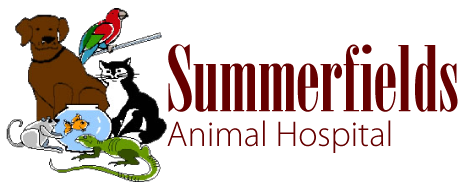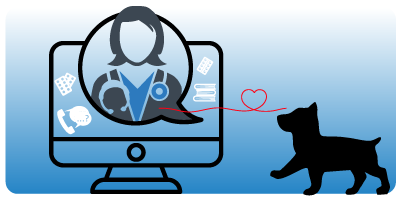High Definition CT Scanning & Fluoroscopy
Low Cost CT (CAT) Scans Available 7 Days a Week for Your Pet!
Summerfields Animal Hospital is excited about the installation of a new advanced CT (CAT) scanner, similar to the equipment used in high-end human hospitals. Computed Tomography (CT) imaging uses X-rays in conjunction with digital X-ray detectors and computer processors to image the patient. A CT scan is sometimes called a CAT scan (for computed axial tomography). For a CT scan, a dog or cat is placed under anesthesia, positioned on a table that slides the pet through a ring containing the x-ray source and the X-ray detectors. The CT images are cross-sectional slices of the area imaged, as if the patient was cut like a loaf of bread. These slices can be examined one by one to reveal the details inside. Contrast agents containing iodine are typically administered intravenously as part of the scanning process to enhance visualization of abnormal soft tissues and blood vessels. Helical or spiral scanner rapidly acquire images of dogs, cats and exotic animals. General anesthesia is typically used because most studies require the patient to remain motionless for a few minutes. A CT scan can take a few minutes to an hour depending on the complexity of the exam, the size of the patient, and the number of body regions examined. After the CT scan is acquired and the patient is awake, CT images can be further processed and reconstructed into three-dimensional and multi-planar reconstruction of structures using computer image manipulation providing exquisite detail for further analysis by radiologists and improvements in diagnosis and treatment planning. Summerfields Animal Hospital is one of the few animal hospitals in our area to have such a powerful machine dedicated solely to animals.
Equipment Good Enough for People in a Safe Environment Designed for Veterinary Patients
Summerfields Animal Hospital provides pet owners affordable access to advanced cross-sectional imaging for their pets on an outpatient basis in an environment specifically designed to be safe for pets. We use Isoflurane gas anesthesia for the rapid recovery and to minimize anesthetic complications. We evaluate patient heart rate, blood pressure, oxygen levels, exhaled gas and electrocardiogram activity during the scans so complications are avoided. Similar state of the art patient monitoring equipment is available for patients under anesthesia, if necessary, for CT or radiosurgery. The imaging equipment available at Summerfields Animal Hospital was purchased from Epica Medical Innovations and is maintained in top working condition under service contract Technicians, who also provide service in human imaging facilities in the area.
Image Interpretation
A board-certified veterinary radiologist is available via telemedicine to assist in determining the imaging modality of choice and provides the most accurate image interpretation possible. We do our best to minimize the time a patient spends away from their owners with us during a treatment or scanning procedure. In most cases, the pet is back with their owner before all the images have been reviewed and a final radiologist report is generated. Written results of the imaging studies are provided to the referring veterinarian managing the patient’s care within 24-48 hours of the imaging study. A digital copy of the imaging study is provided to the owner at the time they pick up their pet. Digital copies of the studies are transmitted to referring veterinarians and off-site hospitals when requested
Fluoroscopy
Fluoroscopy is an imaging technique that uses X-rays to obtain real-time moving images of the interior of an object. In its primary application of medical imaging, a fluoroscope allows a veterinarian to see the internal structure and function of the patient, so that the pumping action of the heart or the motion of swallowing, for example, can be watched. Here is a video of a swallow study with fluoroscopy:
|





